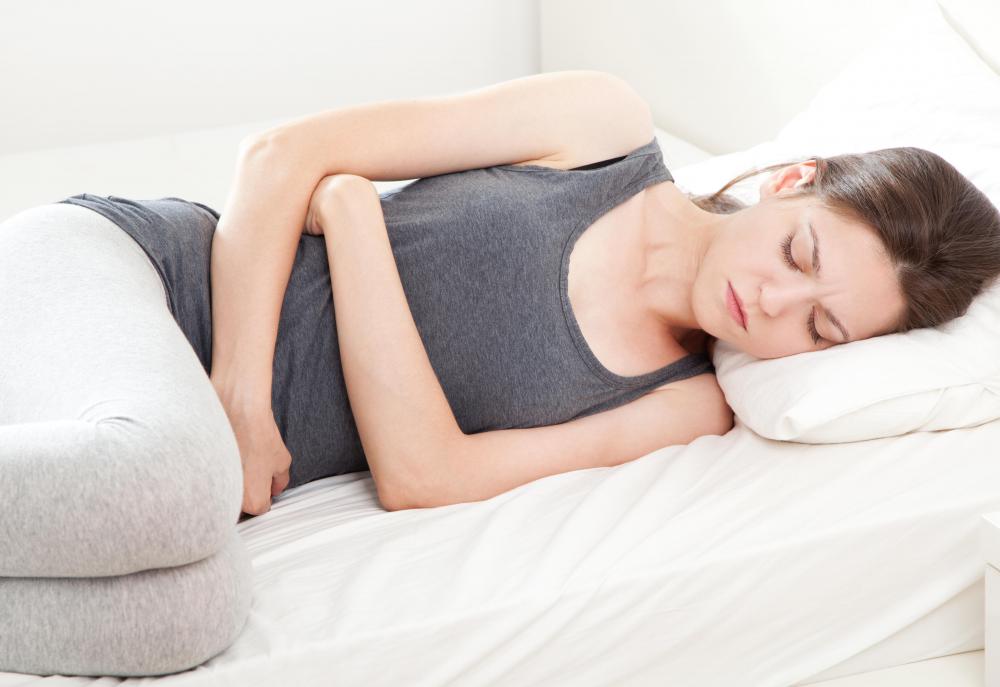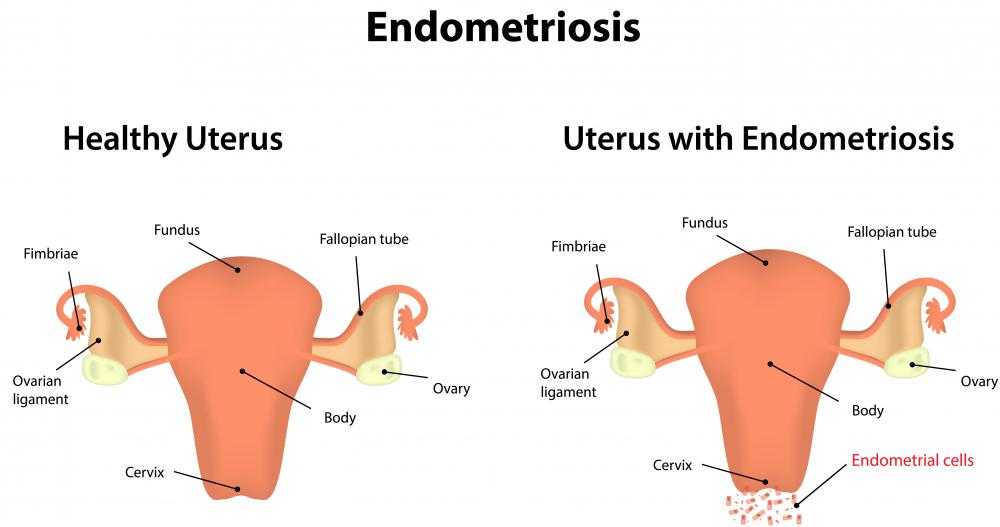At TheHealthBoard, we're committed to delivering accurate, trustworthy information. Our expert-authored content is rigorously fact-checked and sourced from credible authorities. Discover how we uphold the highest standards in providing you with reliable knowledge.
What Are the Common Causes of Uterine Cramps?
Cramps in the uterus, one of the strongest muscles in the female body, can be caused by a number of different things, but menstruation is by far the most common. These sorts of cramps are known medically as dysmenorrhea and they are usually considered a natural occurrence that, while often unpleasant, is not necessarily problematic. Fibroids, growths, or diseases like pelvic inflammatory disease might also be to blame. In pregnancy cramps can be a sign of preterm labor or fetal distress, though intense cramping and contractions are a normal part of childbirth.
During Menstruation

Most cramps occur as a result of menstruation, when the uterus is stimulated to contract and shed its inner lining by various hormones. Women often feel these the most intensely in the days leading up to their periods; in many, once bleeding actually starts cramps disappear or at least lose some of their intensity. The strength of these contractions tends to vary somewhat from woman to woman, too. Some people hardly feel a thing, while others experience a lot of pain. Pain is most common when the uterine contractions constrict blood vessels, but can also simply be a question of intensity.

Cramps that are severe and debilitating typically go by the name “dysmenorrhea.” Symptoms might include weakness, dizziness, nausea, and headaches. This sort of cramping is often a result of hormonal imbalance rather than actual muscular need, and analgesics and hormone therapy can relieve or eliminate most symptoms.
Rarely, complications arising from pelvic pathology such as an abnormality or disease of the reproductive system might cause a disease known as "secondary dysmenorrhea," producing severe cramps after monthly menstruation has ceased. Some women also experience uterine cramps from cervical stenosis, a condition in which an unusually small cervix interferes with menstrual flow.
Fibroids and Other Growths

Foreign growths in the uterus can also cause cramping. Fibroids, also known as benign tumors, sometimes exist in an otherwise healthy uterus and can press the inner walls of the organ. Fibroids are relatively common and can usually be treated with medication or, in rarer cases, surgery.
Adenomyosis, a condition in which noncancerous growths extend into the inner walls of the uterus, can stimulate cramping and pain, too. Scarring from miscarriage, abortion or uterine surgery might also cause complications like uterine adhesion that can lead to cramps. Endometriosis is a rarer cause, but is perhaps the most serious. This is an extremely painful condition in which uterine tissue develops elsewhere in the reproductive system, such as on the fallopian tubes or ovaries. Left untreated it can lead to infertility and hemorrhage.
Pelvic Inflammatory Disease

Pelvic inflammatory disease typically causes both cramps and other pain and swelling. This condition is usually caused by either bacterial or viral infections, sometimes caused by a sexually transmitted disease. It often starts in the uterus and cervical opening but can spread throughout the reproductive system. The disease is usually very treatable with antibiotics and other medications, but if left unchecked it can cause extensive damage that sometimes leads to infertility.
Pregnancy and Childbirth

Light menstrual-like cramps are fairly common in the very early stages of pregnancy, and generally come back in force when it is time for the baby to be born. Strong contractions are required to push the baby down the birth canal and out of the body, and while painful, these typically stop once the child has been delivered.
Cramps at any other time during pregnancy are usually signs of a problem, though. They can indicate a problem with the fetus, or in many cases can also be a sign of preterm labor — basically when the woman’s body tries to initiate birth when the baby isn’t big enough or strong enough to be delivered. Most health care providers recommend that pregnant women get evaluated at the first sign of uterine cramps to rule out any life-threatening conditions. When caught early enough, preterm labor can often be stopped with different medications.
When to Get Help

Women should usually seek the advice of a medical professional any time they experience extreme or debilitating pain along with uterine cramping. Some discomfort is considered normal in most circumstances, but extraordinary pain almost never is and is often a sign of some underlying condition. Taking an over-the-counter pain reliever is effective enough for most people, but when it’s not — particularly if the cramping is accompanied by heavy bleeding, is not happening at the same time as a menstrual period, or is happening during pregnancy — it could be an emergency situation.
AS FEATURED ON:
AS FEATURED ON:


















Discussion Comments
@Grivusangel -- My sister was the same way. Horrible periods.
I had a friend who was having cramps and she went to the gynecologist who said nothing was wrong. She kept having them and finally got a referral to a gyno at Vanderbilt, who bothered to do an ultrasound and she found out she had cancer. Fortunately, she was able to have a hysterectomy and has been cancer-free for over five years, but repeated cramps are nothing to ignore or play with. If you don't get answers, keep asking and going to other doctors for help, until you get the right answer, the right diagnosis and the right treatment. Be your own best advocate!
Don't get me started on cramps. Oh, Lord. I started having periods when I was ten, and my cramps were hideous. I'd never hurt so bad in my life -- and I haven't since. Not even childbirth was as bad!
Back then, in the Dark Ages, about all they had to help the pain was Tylenol and Pamprin. Neither of them touched it. My mom worked for a doctor and I took prescription Motrin until she finally got hold of some Anaprox, which is the prescription version of Aleve. That's the only thing that gave me any relief until I got on birth control pills.
Post your comments